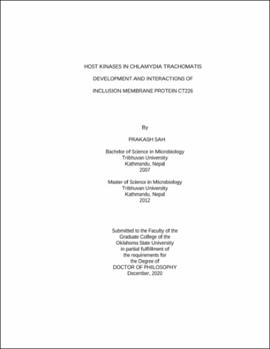| dc.contributor.advisor | Lutter, Erika | |
| dc.contributor.author | Sah, Prakash | |
| dc.date.accessioned | 2023-04-26T16:20:26Z | |
| dc.date.available | 2023-04-26T16:20:26Z | |
| dc.date.issued | 2020-12 | |
| dc.identifier.uri | https://hdl.handle.net/11244/337473 | |
| dc.description.abstract | Chlamydia trachomatis is an obligate intracellular pathogen that causes sexually transmitted infections and blinding trachoma. Inside the host cell, C. trachomatis replicates within a vacuole called the inclusion. Many of the Host-Chlamydia interactions occur at the inclusion membrane where chlamydial inclusion membrane proteins (Incs) as well as several host proteins localize. This study aimed to study the role of host kinases recruited at the inclusion and characterize host interactions of Inc, CT226. In this study, we showed that several isoforms of the host protein kinase C (PKC) are recruited at the inclusion microdomains, PKC substrates localize to the periphery of the inclusion and this recruitment is limited to C. trachomatis serovars. PKC substrates were phosphorylated differentially during infection. Pharmacological inhibition of PKC resulted in a modest decrease in infectious progeny production by C. trachomatis. Protein kinase A catalytic subunit α (PKA-Cα) and regulatory subunit II α (PKA-RIIα) were found to co-localize with the Golgi marker, golgin-97, close to the inclusion. PKA substrates were found to be recruited to the inclusion periphery in a time dependent manner. Phosphorylation of PKA substrates including glycogen synthase kinase-3β (GSK-3β) increased over time during C. trachomatis infection. Pharmacological inhibition of PKA resulted in a decrease in extrusion production by C. trachomatis. Investigation of CT226 interactions by co-immunoprecipitation assay showed CT226 interacts with FLII, LRRFIP1, and TMOD3. Recruitment of FLII, LRRFIP1, LRRFIP2, and TMOD3 was observed at the C. trachomatis inclusion. Deletion of CT226 resulted in loss of FLII recruitment, altered recruitment of LRRFIP1 and TMOD3, while no effect was seen on LRRFIP2 recruitment. Our data indicate FLII may be the primary host protein interacting with CT226. | |
| dc.format | application/pdf | |
| dc.language | en_US | |
| dc.rights | Copyright is held by the author who has granted the Oklahoma State University Library the non-exclusive right to share this material in its institutional repository. Contact Digital Library Services at lib-dls@okstate.edu or 405-744-9161 for the permission policy on the use, reproduction or distribution of this material. | |
| dc.title | Host kinases in chlamydia trachomatis development and interactions of inclusion membrane protein CT226 | |
| dc.contributor.committeeMember | Hadwiger, Jeffery | |
| dc.contributor.committeeMember | Patrauchan, Marianna | |
| dc.contributor.committeeMember | Wozniak, Karen | |
| dc.contributor.committeeMember | Jones, Clinton | |
| osu.filename | Sah_okstate_0664D_16960.pdf | |
| osu.accesstype | Open Access | |
| dc.type.genre | Dissertation | |
| dc.type.material | Text | |
| dc.subject.keywords | chlamydia | |
| dc.subject.keywords | host-pathogen interactions | |
| thesis.degree.discipline | Microbiology, Cell, and Molecular Biology | |
| thesis.degree.grantor | Oklahoma State University | |
